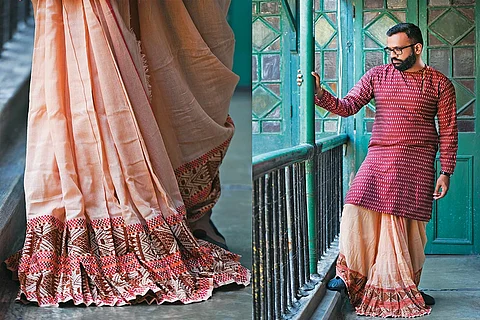
- Destinations
- Experiences
- Stay
- What's new
- Editor’s Picks
- Responsible Tourism
- CampaignsCampaigns
- Subscribe

The Shantipuri sari, in a way, can be compared to today's denim," said Amitra Sudan Saha, revivalist at Ssahaworks Studio. "It was for everyday use. The sari was worn by Brahmo Samaj girls as a customary school and college uniform."
The legendary Shantipuri sari is a centuries-old tant derived from Shantipur in the Nadia district of West Bengal. This ancient handloom industry has been mentioned in manuscripts that glorify the life of Advaita Acharya and Bengali folklore.
"The traditional art of weaving in Shantipur in Bengal is said to have begun in 1409 AD during the reign of Gaur Ganesh Danu Mardhandev," said Saha. This sari-weaving practice flourished in the late 17th century under the rule of the Nadia king, Rudra Roy, and has continued ever since.
The craft gained prominence during the Mughal-era, when sari production became systematised, leading to their export to countries like Afghanistan, Iran, Arabia, Greece, and Türkiye. The unique quality of Shantipur saris, woven from hand-spun yarn of 200-300s, distinguished them in the market, and they could easily compete with imported Manchester cotton yarn.
Despite their elegant simplicity, a Shantipur sari is deceptively complex. "The anchal, or pallava, of the Shantipur sari, often features butis or jamdani designs in extra weft, beautifully arranged alongside various stripes," said Saha. Eye-catching Shantipur varieties include Ganga-Jamuna, Benkipar, Bhomra, Rajmahal, Anspar, Do-Rookha, Visva-Bharati, and Brindamani Mour-Par. The renowned Nilambari sari of Shantipur is known for its deep navy-blue colour—a result of indigo, and it is reminiscent of the night sky on a new moon. Some Nilambaris have borders fringed with silver zari stars.
Traditional Shantipur saris often have pallavas decorated with stripes of varying thicknesses, called sajanshoi, in colours complementing the border. The ground of the sari often features fine checks, stripes, or textures created by coloured threads or a combination of fine and thick yarn counts. The sari borders, or paars, have picturesque names like bhomra (bumblebee), tabij (amulet), rajmahal (royal palace), ardha-chandra (half moon), chandmala (garland of moons), ansh (fish scale), hathi (elephant), retan chock (gem-eyed), benki (spiral), tara (star), and phool (flower).
Historically, Shantipur saris were smoother due to a unique sizing technique for the yarn. Both warp and weft were sized, a practice rarely followed today.
The decline in this craft is attributed to a the influx of cheap, machine-made products.
The revival project for Shantipur tant began by chance. Saha’s studio had been focused on reviving the Bengal muslin jamdani, until they stumbled upon a fine muslin sari with intricate borders. Further research revealed this was an old Shantipur sari, a rare find from a bygone era.
Saha’s team is collaborating with artisans and experts to replicate the feats of weaving achieved hundreds of years ago. The intricate project involved finding traditional weavers, gaining their trust, and reigniting their pride in the craft. Extensive fieldwork identified weavers who were knowledgeable about Shantipur's unique weaving techniques. The work also entailed in-depth design research to reimagine traditional motifs for the modern market, alongside a technical understanding of the complex creation process. One of the most challenging aspects of the revival was resurrecting the lost technique of sizing and treating handspun yarn, a technique critical to the softness that defines Shantipur saris. "Through trial, error, and collaboration with older weavers, we successfully brought this technique back, ensuring that the revived saris would have the same delicate feel," said Saha.
The revival project was officially launched in 2024 at the Birla Academy with the support of the Crafts Council of West Bengal.
In August, Shantipur tant basked in the glory of an exclusive event, "The Threads of Time," which artfully narrated the story of resuscitating the centuries-old Shantipur textile. "By honouring the past while adapting to the present, we have created a platform where the craft of Shantipur can once again thrive, ensuring that this rich cultural heritage is preserved for generations to come."
